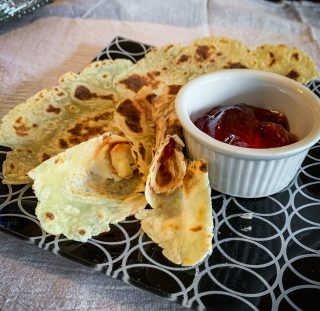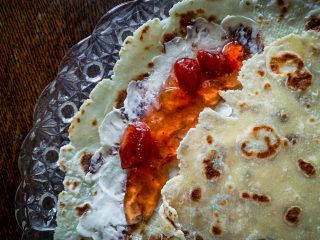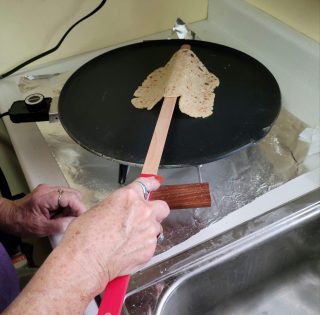
Norwegian family turns baking tradition into holiday fundraiser for St. Jude
Tapping into their Norwegian roots, Minnesota family makes and sells lefse bread to benefit kids in need.
Lynda Tysver’s Norwegian roots run deep, and so does her dedication to St. Jude Children's Research Hospital. Each year, she and her family make Norwegian lefse bread for the holidays, and now she sells it as a fundraiser for her St. Jude Heroes campaign. Here, she shares her lefse baking tips and traditions.

How many lefse orders have you gotten for your St. Jude fundraiser this year?
We have 100 for Thanksgiving, and we have almost 100 now for Christmas.
Can you describe what lefse is?
So, the easiest way for me to explain it is that it’s a Norwegian tortilla. But instead of corn or flour, it’s potatoes. My family makes it every year for the holidays.
Is it a savory experience or a sweet one? Or does it depend on the topping?
Yeah. So, it’s Scandinavian, so it’s kind of … bland. It’s more of a bread. I grew up where you either put just butter on it if you were a die-hard, old-school, farm-type person. Or us kids always put sugar on it. A lot of people heat it up, slather it with butter and put cinnamon and brown sugar on it. More recently, I’ve heard of people putting lingonberry spread on lefse, but I’ve never done that.

Tell me about the lefse traditions in your family.
As far back as I can remember, it was always on the table for Christmas as part of our Christmas Eve dinner, and any leftovers were definitely eaten all day long on Christmas Day.
I remember watching my grandma make it and always wanted to learn, but she died when I was in fourth grade. One year when I was in college, I spent the holiday break in Colorado with my Auntie Sylvia on my mom’s side, and I asked her, “Will you teach me?” And she said, “Of course!” So we had a great time and she taught me how to make lefse.
I came home to Minnesota and announced to my family that I would be carrying on the lefse tradition for our family. But it’s definitely a group activity or assembly line with different family members at different lefse stations. I make it with my mom and dad, my sister and her husband, and my nieces and nephews. We started teaching my niece Kaitlyn when she got old enough to see over the table, and now Kaitlyn, Hailey, Caleb and Jack have all been baptized by flour.
And it’s great because you’re already mentoring your nieces and nephews into being St. Jude Heroes, and you’re mentoring them into this lefse tradition, which in turn raises money for your Heroes campaigns. That’s really cool.
We thought so!
Is there a trick to lefse making? What does a new lefse maker have to know?
Make sure you have an extra cup of flour on hand to keep your dough from sticking when you roll it.
You want your dough to be chilled. You don’t want it room temperature.
You want your rolling pin as long as possible so you can roll it out completely and not have those little edges and grooves.
When you put it on the grill, you want to watch it because if you don’t, it could catch on fire.
You always want to make sure you have a legitimate lefse flipper.
A legitimate lefse flipper?

A long stick. They manufacture them, but my grandma always said, “Just go and get a branch off a tree and cut it and smooth it out.” The ones you buy in stores are between two and three feet long, and no more than a half an inch wide. And so you slide it underneath the tortilla so you can lift it. You do that when you’re rolling and when you’re flipping it on the grill.
And then the last thing is always make sure you’re putting it in a cloth towel to keep it fresh and soft longer.
Do you store the lefse in the fridge?
Yep. And usually when I reheat it, I just pop it in the microwave for 20 seconds.
Are you excited about the process of making them this year?
Yes. My dad is 100 percent Norwegian. He has a really dry sense of humor, kind of a combination of Johnny Carson and Bob Newhart. But when we’re making lefse, he turns into a little kid. That first time he taught the grandkids to make lefse, he told them, “Now the secret to making good lefse is in my hands.” And Hailey got really close and said, “What’s the secret?” and he blew the flour, and she was just covered from head to toe.
He turns into a little kid, and we have fun. It’s my favorite time of the year.
Auntie Sylvia Family Lefse Recipe
- 1/3 cup boiling water
1 2/3 cups of instant mashed potato flakes
1 2/3 cups half & half
3 tablespoons butter (do not substitute margarine or another type of oil)
1 teaspoon salt
1 cup flour
1 cup flour additional for rolling
Add potato buds, half & half and butter to boiling water. Whip together with a fork or use a food processor to combine until a smooth dough forms. Put in a glass bowl, cover with a paper towel and refrigerate until cold, at least 4 hours to overnight.
Once cold, add salt and flour. Use hands to mix well. Once mixed, roll into a long, jelly-roll style log. Slice into approximately 16 pieces, place on a plate and refrigerate uncovered.
Take one piece at a time from the refrigerator. Do not let it get too warm or it will stick to your rolling pin. Sprinkle flour on your rolling surface to help avoid sticking.
Place your dough on the flour and start to roll. Roll out evenly and flip it over adding more flour if necessary to avoid sticking to surface and rolling pin. Roll as thin as possible without sticking and you are able to move to grill.
Bake on lefse grill (griddle or skillet can also be used) at 475-500 degrees, flipping until it bubbles and you see light brown spots appear on both sides.
Cool between dish towels to keep soft.
Serve with butter. Add sugar, cinnamon and lingonberries as desired.





